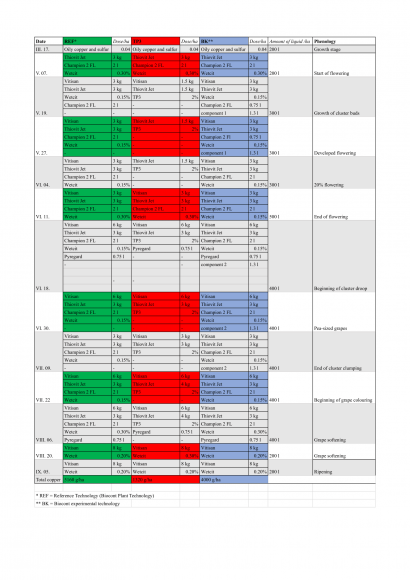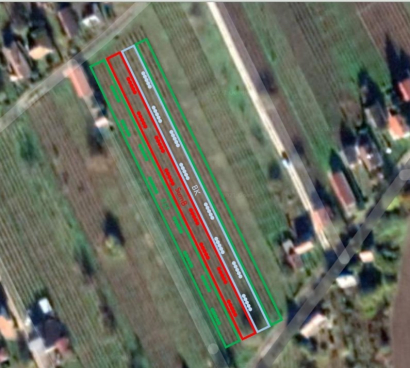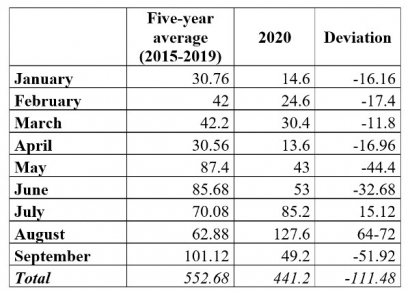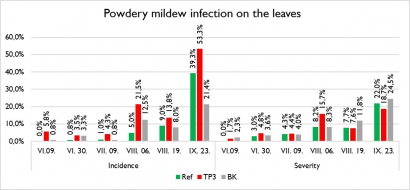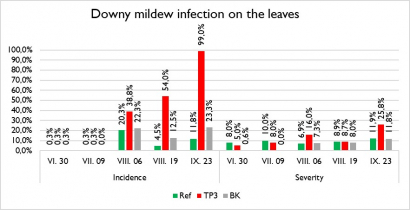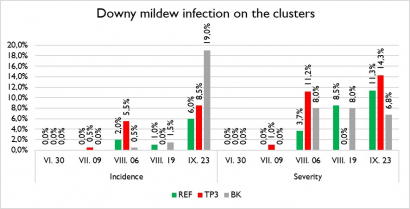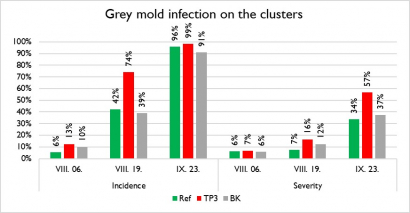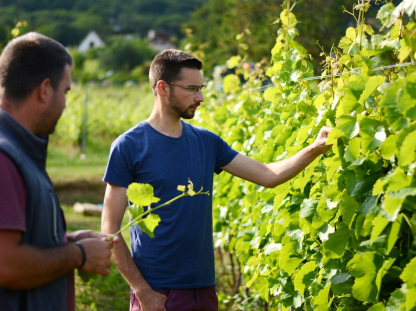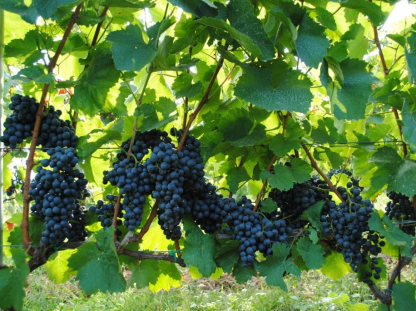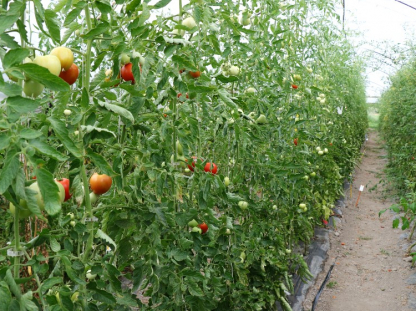Organic Plant Protection Experiment in the Nagy-Somló Wine Region
The Aim of the Experiment
In 2020 we conducted a new experiment following up the copper-replacement tests of the RELACS Horizon 2020 project, and thus, supporting the transition of the Nagy-Somló wine region to organic farming (catalyzed by the Biocont Magyarország Kft. and the wine-growing community). The aim was to assess whether it would be possible to protect against grape downy mildew (Plasmopara viticola) in organic while also reducing the use of copper-based fungicides – a mainstay of organic plant protection – in the interests of sustainability. We have previously (in Agrofórum 2020/5) explained in greater detail the concerns regarding the excessive/overly blunt use of copper for plant protection purposes, which primarily relate to its accumulation in the soil, leading to unfavourable conditions for many useful living organisms. In addition, according to European Union directives, the total amount of copper used in organic farming may not exceed 28 kg across 7 years, i.e. an average of 4 kg/ha per year.
Presentation of the experimental area
We set up our experiment on a south facing location at the foot of Somló Hill, an extinct volcano (Figure 1). This proved an advantageous location, because the unique climate here is ideal not only for growing high-quality grapes, but also for Plasmopara viticola, even in years when it is not widespread elsewhere. In this wine region, the total hours of sunshine vary from between 1900 and 2000 per year, with an average annual temperature of 9.8°C and, on average, 550–700 mm of annual precipitation.
We examined the different technologies at a vineyard of old vines of the Juhfark variety, planted in the 1980s. The canopy managed as low cordons. Within the vineyard, the row spacing was 2.1 m, the plant spacing was 1 m, and each plot consisted of 16 rows. At the beginning of the experiment, in April, after the mechanical cultivation of the inter row covered with natural weed flora, a species-rich inter-row grass mix was sown. However, as a result of the dry spring, the cover plants appeared infrequently and late, and eventually the local weeds reclaimed their former preponderance, so that the area had to be mown twice during the summer.
Aside from the unique character of the grapes being studied, known locally as ‘the wine of the wise’, it is also worth noting that its cluster is dense and the peel of its berries is thin, making the grape berries prone to cracking and especially susceptible to grey mould (Botrytis cinerea). That is why, although it is used to make the region’s most iconic wine, it is not a variety specifically recommended for organic farming. Nonetheless, several well-known wineries do successfully grow it using organic technology.
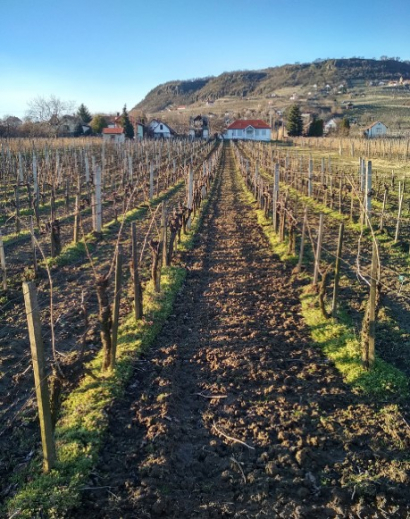
Figure 1 and 2. The vineyard at the end of February and the day before harvest. (Photo: Bence Trugly, 2020)
Experimental Agents and Technologies
During the study we tested three technologies (Table 1).
As a reference (REF) we selected the proven operative technology of Biocont Magyarország Kft. which, in addition to copper- and sulphur-containing fungicides, is based on Vitisan, apotassium bicarbonate, and Wetcit, a terpene derived from ethoxylated fatty alcohol and orange. In this treatment line, the liquid, low-copper hydroxide Champion 2 FL was primarily developed to protect grapes from downy mildew, while additional protection against powdery mildew was provided by a combination of Kumulus S (sulfur), Vitisan and Wetcit. The last element in this tank mix also helps to spread the droplets, thus providing better coverage.
With regard to the RELACS experimental technology, we based protection against downy mildew on a contact mechanism containing a tropical plant extract. This experimental agent and the technology based on it are hereafter referred to as TP3. The plant protection substance which forms the basis of the treatment sequence in the experimental phase is only active for a relatively short time (5−7 days), so in this case it is not the continuous presence of the active ingredient that is most crucial, but rather correct timing. During the first treatment, and then again during flowering (this being the most critical period) the same tank mix as the reference technology is applied as per the product owner’s recommendation. Previous foreign studies on the product with the codename TP3 have also found it is effective against powdery mildew. Although the disease is less significant in those countries than in Hungary, we initially used half the recommended dose of Kumulus S and Vitisan, which are present in the reference technology, and we completely omitted Wetcit, due to the oil content of TP3. However, at the beginning of the experiment, we observed a higher flow rate with this technology, despite using the same amount of water as for the reference treatment, so we completely abandoned Vitisan. However, based on the crop condition, we decided that more effective protection against powdery mildew was needed with this technology, so Vitisan was returned to the tank mix, while the sulphur dose was gradually increased until the amount of Kumulus S in the mix exceeded the reference amount.
The third series of treatments studied is based on a two-component combination of the Biocont experimental technology (hereafter referred to as BK). It should be used as a precautionary measure until the first symptoms of downy mildew appear. It consists of a mixture of Saccharomyces sp. extract, copper (approximately 3%) and other micronutrients. This agent improves the plant's defences, thus reducing the risk of diseases becoming established. After the pathogen has successfully infected the plant and the first symptoms start to appear, the second pieces of the product pair should be used. It is a contact agent containing natural enzymes, Lactobacillus sp. and plant extracts, which create unfavourable conditions for the pathogen on the surface of the treated plant parts. In addition, it contains micronutrients (such as manganese and zinc) that play an important role in activating the plant's defences. These formulations mix well with copper, but can also be used to help reduce the amount of copper needed. According to the manufacturer's recommendation, the possibility of reducing the standard amount of copper when using this technology depends on the vintage of the plants, infection pressure, wine region and the sensitivity of the variety. In case of mild to moderate infection, the amount of copper applied can be reduced, but in case of severe downy mildew infection, the usual dose of copper should be used.
The last two treatments were the same for all three technologies, which were targeted to the cluster zone to slow the spread of grey mould.
The Experimental Methodology
The experiment was set up on a 0.4 ha plot (Figutre 3), where truncation, shoot and cluster sorting took place several times, and leaves around the clusters were removed at veraison. The various treatment technologies were applied to 4−4 (0.1 ha) rows with a backpack sprayer. Adjacent 2−2 rows of different technologies were considered as internal buffers, and pathological assessment were performed on the vines of the middle 2−2 rows. We examined 10 leaves and five clusters per plant, 5 plants per plot, and 4 plots per row, from cluster elongation to harvest. The experiments were performed on a total of 6 occasions. At flowering (09/06), when the berries reached the size of green peas (30/06), at the beginning of berry softening (06/08), at the end of softening (19/08), and finally at harvest (23/09).
During the assessments, the number of plant parts infected with powdery mildew, downy mildew, and grey mould were recorded, from which the incidence of infection could be calculated. The percentage of infected areas for each plant part was also recorded, with the average of these values giving us the severity of infection.
Characteristics of the vintage
On 6 May we installed an iMetos IMT-200 meteorological station in the experimental area, meaning that we were able to monitor the weather conditions based on accurate data, and could also use data modelling to observe the risk of infection by individual pathogens (Figure 4).
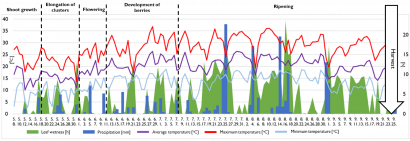
Figure 4. Temperature, precipitation, and leaf humidity during the experiment (Somlóvásárhely, 2020)
The buds on the vines began to sprout in late March and early April, but during that period the temperature still dropped below freezing on several occasions, so we observed some frost damage in the spring. Due to the rapid temperature increase which began in mid-April, intensive shoot growth took place relatively quickly. However, from the second half of May, just before cluster elongation, a significantly cooler period began, and lasted until the middle of June, prolonging cluster elongation. Flowering took place at different rates in different parts in the vineyard, so it lasted for a relatively long time. The beginning of berry development, with the exception of a short warm period, was characterized by mild weather, and from the end of June hot spells became increasingly frequent. Apart from a few pronounced but brief cold periods during ripening, there was roughly uniform warm weather until early September, when a sudden drop in temperature occurred. The warmer period that followed was broken only by a three-day cold period a few days before harvest. Thus, resulted in rapid increasing of sugar content in the berries, allowing an early harvest on 24 September. Examining the temperature data, only the cool late-spring−early-summer period and the significant daily temperature fluctuations are noteworthy, this would not be enough on its own to mark this vintage out as exceptional (Figure 5).
A closer look at rainfall patterns, however, reveals a different situation. It quickly becomes apparent that while 2020 can be said to a dry year in this area based on the overall amount of annual precipitation, its distribution can be considered extreme. The spring period was characterized by an extreme drought, which was not conducive to early infection by fungal diseases. Between 6 May and 24 September, a total of 342.2 mm of precipitation fell in this location, the vast majority (293 mm) during ripening (Figure 4, Table 2). This large amount of intense precipitation, in turn, caused the berries to crack during ripening, thus clearing a path for grey mould infections.
In the experiment, we focused primarily on controlling of downy mildew. This disease pathogen can cause infections in two ways. At the beginning of the vegetation, sexual reproduction formulas (oospores) formed as a result of the previous year's infection, overwintering on fallen leaves, develop within ten days after relatively high levels of precipitation (at least 10 mm) over a couple of days, if temperatures rise to 10−13 oC during the day and at least 10 oC at night. The resulting macrosporangia contain the zoospores responsible for the infection, which, when raindrops splash them onto lower leaves, penetrate the leaf tissue (mainly from leaf back) and then spread to form yellowish, so-called ‘oil spots’ on the leaves. This mode of infection is hereafter referred to as oospore infection. Once the disease has developed, over time, the pathogen begins to form sporangia, which appear on the surface of plant parts forming a layer of soft, white mould. These asexual reproductive formulas then spread the disease in that vegetation, hereafter referred to as infection by sporangiospore. Sporangia can also travel longer distances, are viable for between 3 and 20 days, and can infect plants when rain falls in their presence. In the water droplets surrounding the sporangia, the sporangiospores released from them can infect grapes in the same way as zoospores, even after just two to three hours of leaf surface moisture.
According to meteorological models, conditions became favourable for the first downy mildew sporangiospore infection in mid-June, while oospore infection could have occurred as early as mid-May. Moreover, until the end of flowering, the conditions for this mode of infection were almost always favourable. In fact, however, the symptoms developed as a result of infection by sporangia carried on the southern winds, presumably due to the small amount of overwintering inoculum (Figures 5 and 6).
The powdery mildew (Erysiphe necator), another key player in our study, is able to overwinter in buds by means of a vegetative body (mycelium). From these buds, a distorted, mycelial-covered shoot develops in the spring, on which asexual propagation organs (conidia) are formed. Conidia are able to germinate at 15–27 oC and 96 % relative humidity, thus creating another infection. However, if the temperature permanently drops below -15 oC, the mycelium overwintering in the bud may be damaged and lose infectivity. While in the past this mode of infection played an important role in the spread of epidemics in Hungary, today that seems to be changing.
More resistant than mycelium, the powdery mildew fungus has a hard-walled fruiting body which is visible even to the naked eye, known as the chasmothecium. Spherical chasmothecum can also leach into the cracks in the woody parts of vines. As a result of spring precipitation (at least 5 mm falling within 10–14 days after the leaves opened), the chasmothecium swells and ruptures, at which point the ascuses in it release ascospores, which can also infect the surface of the leaves. The first symptoms therefore appear on the back of leaves close to the trunk. According to the model, the risk of powdery mildew ascospore infection became significant from the second half of May (Figure 7).
The grey mould pathogen is a fungus that is present almost everywhere and in large quantities. It has an extremely wide range of host plants, and can also utilize dead organic matter (opportunistically saprophytic). The sexual form of the pathogen rarely develops under natural conditions, but the asexual reproductive organ, the sclerotium, can withstand very extreme conditions. At atmospheric temperatures of 20–25 oC and a relative humidity of 92–97 %, sclerotia form conidiophores and conidia, which can germinate on a wet plant surface at 18-20oC. In 2020, the splitting of berries due to heavy rains provided favourable conditions for grey mould infection.
Results
The first symptoms of powdery mildew were observed on the shoots as early as June 4, but at the time of the first recording (5 days later) their occurrence was not yet widespread. Significant infection was first observed in early August, at which time infection was both more frequent and more severe in TP3 plots than in the reference area, and this trend continued until the third quarter of August (Figure 8). Although the incidence of infection was highest on TP3 plots, the severity of infection was slightly different in the last two assessment. It was most widespread on BK plots.
Significant levels of powdery mildew were found on the clusters at the end of June. The rate of infection was highest on TP3 plots throughout, presumably because the pathogen was not adequately controlled during early treatments here (TP3 did not show the expected efficacy against powdery mildew) and because we only used contact-effect agents where the pathogen had not been combatted earlier, and thus could continue to multiply in safety. At the beginning of August and just before harvest, we found that clusters in TP3 plots were more infected than those where the reference and Biocont experimental technologies were used (Figures 10 and 11). Infections in plots where the reference and Biocont experimental technologies were used developed very similarly in frequency and extent until the last two recordings, but on the last two occasions the symptoms of the Biocont experimental treatment were less pronounced, and on the last occasion we found even smaller amounts than on the REF-treated clusters.
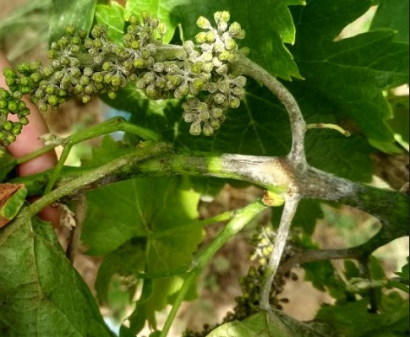
Figure 10 and 11 Shoot covered with powdery mildew mycelia in early June (left) and maturing casmothecia in late September (right) (Photo: Bence Trugly, 2020)
Peronospora, although an annual visitor to the Nagy-Somló wine region, appeared quite late in 2020. Significantly, we did not find any symptoms until the beginning of August, and even then mostly on the top shoots. These shoots soon fell victim to truncation, thereby significantly reducing the infectious pressure of the pathogen. Examining the leaves, we found that after the mass appearance of Peronospora, the pathogen was much more common on TP3 plots than on REF plots, and had killed more than 25% of the foliage by harvest time (Figure 10−15). In addition, significant foliage loss was observed on the rows treated with TP3 technology, so actual foliage loss could be even higher. The experimental Biocont technology also showed a bit more frequent infections than in the reference rows. However, in the case of Biocont's experimental technology, the application of the experimental product pair (in the absence of downy mildew infection) was completed relatively early (08/07), and subsequently, this area received copper at the same dose as the reference plot, to protect it against Peronospora. Therefore, the results of subsequent evaluations (06/08, 19/08, 23/09) are not relevant with regard to the efficacy of the Biocont experimental product.
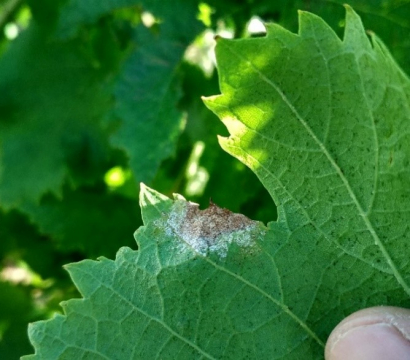
Figure 13 and 14 Leaf infected with Peronospora, with soft, sporangium-bearing growth (Photo: Bence Trugly, 2020)
Because downy mildew appeared rather late in the area (at the beginning of veraison), the clusters were no longer susceptible to infection, and no damage comparable to that suffered by the leaves was found for any of the technologies. Only when plants were treated with the Biocont experimental treatment were rates of infection higher than with the other two treatments, but the degree of damage was much lower in the infected clusters than among those treated with either the conventional technology or TP3.
Considering the characteristics of the variety and the vintage, it could already have been guessed that grey mould would be responsible for the greatest loss of yield. Due to the sudden heavy rainfall during veraison, partly due to osmosis and partly due to increased root pressure, the grapes became more swollen than would have been wished, and in the dense clusters they split or were crushed, thus offering the grey mould an easy entry into the berries (Figure 17). In the absence of absorbents, it was difficult, if not impossible, to limit the spread of the pathogen. On 6 August we noted only the warning signs of significant infection, but two weeks later the presence of the pathogen in the clusters was observed to be significantly higher. At that time we found much higher rates of infection on TP3 plots, and by harvest time the other two technologies were approaching the same frequency. By contrast, the rate of infection was much lower on the conventional and experimental Biocont plots (Figure 16). However, this high degree of infection had the most negative effect on yield, and resulted in an excessive increase in sugar content.
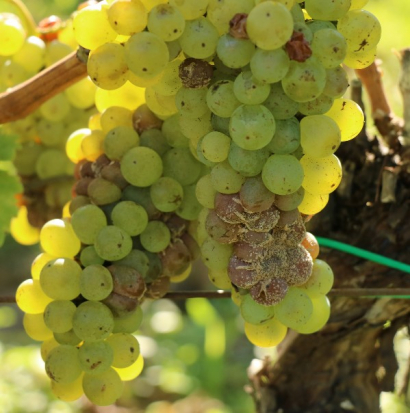
Figure 17: A cluster infected with grey mould, showing the dense, conidia-bearing mould (Photo: Bence Trugly)
Although copper cannot directly inhibit botrytis infection, in this case we found that when it was largely omitted, the pathogen proved able to cause much more widespread infection. The tissue-strengthening effect of copper treatment is thought to play a role here. In addition, the observation that the agent underlying the TP3 technology caused a thinning of the wax layer of the berries should not be overlooked. What is more, the significant loss of foliage suggests that while treatments were not always applied at the ideal time (it is unfortunately not always possible in practice to apply preventative measures when they are most effective against a pathogen), this short-acting contact agent proved unable to control peronospora, even in a non-epidemic year, and despite the application of fungicides equivalent to nearly 1.5kg/ha of metallic copper. Although the treatment appeared promising based on previous studies, its formulation and applicability require further development.
Summary
In the case of the reference technology (REF), downy mildew and grey mould caused significantly lower levels of infection than TP3, but fungicides equivalent more than 5 kg of metallic copper were applied per hectare, meaning that plant protection should be managed using proportionately less copper in future years, bearing in mind the legal ‘copper limit’. It should be noted, however, that the reference technology was based on a form of protection that is valid at all times, rather than being a template tailored to a particular vintage. Reduced copper consumption would also have been possible in the current year, with appropriate adaptation. This is confirmed by the results for rows where Biocont's experimental (BK) technology was used, where the 4 kg/ha copper limit was not exceeded and no pathogens were observed to have significantly higher levels of infection than with the reference technology, although the application of the experimental agent was completed long before infection pressure began to rise. The protection result obtained here thus also supports a form of adapted copper application strategy.
There is a growing perception that although copper has unfavourable properties, and despite its excessive and overly blunt use, it is at the same time very cheap, has a broad spectrum against bacterial and fungal diseases and a beneficial effect on plants, and is both easily accessible and easy to use. For this reason, the complete abandonment of copper-containing products in organic plant protection remains a difficult goal to achieve. However, the level of utilization can be significantly reduced if in addition to promising new technologies we use all available agrotechnical possibilities, (e.g. planting more widely spaced vines) and plant more resistant varieties, even when they are not as marketable as wines made from better known grapes. The use of in-depth, multi-vintage experience and prediction models, based on a knowledge of the biology of the pathogens for a given vineyard, field, and variety, provides an opportunity to further reduce pesticide load.
Growing a grape variety with a stronger skin and looser clusters also helps a great deal in controlling grey mould. Alongside our experiment, a plant protection practice that was exactly the same as the reference treatment was carried out in a neighbouring Welschriesling vineyard. Although we only visually inspected the crop, and no survey was carried out, it was clear that neither grey mould nor other pathogens were present to a remotely comparable degree. Nonetheless, Juhfark's well-known place in Hungarian wine production is indisputable, and although its cultivation is not very typical outside the Nagy-Somló wine region, it remains extremely important there. In addition to preventing the berry cracking which is so typical of the variety, targeted treatments against botrytis require further development, and possibly new active ingredients.
Bence Trugly, Dr. Dóra Drexler
ÖMKI, Budapest
Laura Jávorszky, Ágoston Tóth, István Nagy
Biocont Magyarország Kft., Kecskemét
References:
- Glits M., Folk Gy. (2000): Kertészeti növénykórtan [Horticultural Plant Pathology], Mezőgazda Kiadó, Budapest pp. 280−296.
- Bényei F., Lőrincz A. (2005): Borszőlőfajták, csemegeszőlő-fajták és alanyok [Wine Grape Varieties, Table Grape Varieties and Rootstocks], Mezőgazda Kiadó, Budapest pp. 118−119.
- Commission Regulation (EC) No 889/2008 of 5 September 2008 laying down detailed rules for the implementation of Council Regulation (EC) No 834/2007 on organic production and labelling of organic products with regard to organic production, labelling and controlCommission Implementing Regulation (EU) 2018/1981 of 13 December 2018 renewing the approval of the active substances copper compounds, as candidates for substitution, in accordance with Regulation (EC) No 1107/2009 of the European Parliament and of the Council concerning the placing of plant protection products on the market, and amending the Annex to Commission Implementing Regulation (EU) No 540/2011 The website of the Nagy-Somló wine region – https://www.somloiborvidek.hu/a-borvidekrl
- Dula Bencéné (2021) – Elméleti és gyakorlati alapismeretek a szőlő járványos betegségeiről és leküzdésükről (2.) – A szőlőlisztharmat [Basic theoretical and practical knowledge about grape epidemics and their control (2.) − Grape powdery mildew.]. Agrofórum, 32 (9): 158−
